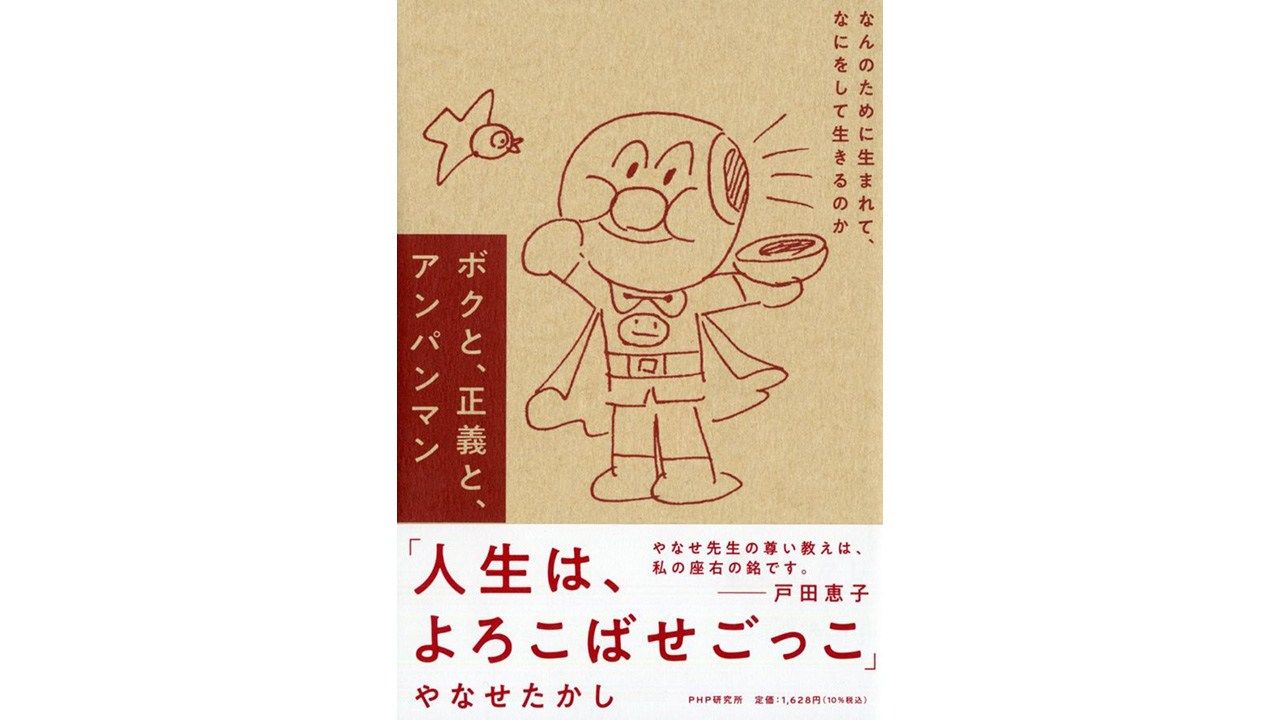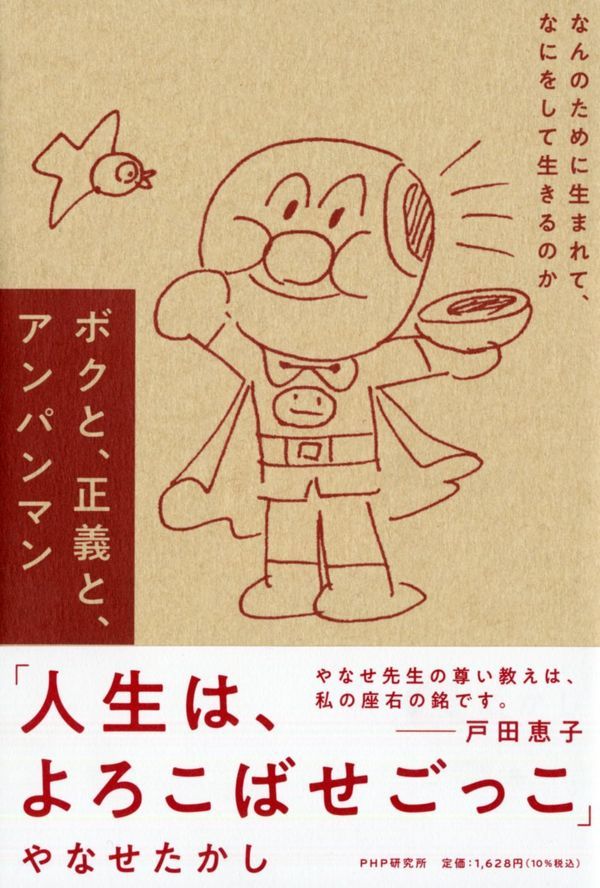
Deep Thoughts from a Bean-Jam-Bun Hero: Essays from Anpanman Creator Yanase Takashi
Books Anime- English
- 日本語
- 简体字
- 繁體字
- Français
- Español
- العربية
- Русский
Japan has given birth to many heroes, but one hero that probably everyone knows is Anpanman—literally, “Bean Jam Bun Man.” No matter how old I get, when I see that familiar face, I hear the anime’s theme song in my head―”Yes, that’s right. Don’t be afraid. Stand up for everyone.”
Anpanman was born in a bakery and his head is made from anpan, a bun filled with sweet bean paste, but he has a body like that of a human. If he hears that someone is in trouble, he flies off into the sky to help them, and if they are hungry, he gives them some of the anpan that his face is made of to eat. (This does him some damage, but he can get a new face at the bakery, over and over again.) When his archrival, Baikinman, (Bacteria-man) is mean to him, Anpanman teaches him a lesson with his special technique, the “An-Punch.” Anpanman is always doing good things, and he’s a popular hero with children.
Other cute characters created from food include Shokupanman (White Bread Man), Karēpanman (Curry Bread Man), Kurīmupanda (Cream Panda), and Tendonman (Tempura Rice Bowl Man). Together with these friends, Anpanman defeats Baikinman and his gang. But even so, I think Anpanman and Baikinman might actually be good friends.
As I got older, I had less and less contact with Anpanman—that is, until I became a mother myself.
With my three children all still under the age of 10, our house is filled with Anpanman picture books, Anpanman toys, Anpanman DVDs, stuffed toys of Anpanman, Anpanman clothes, and much more. Before I realized it, we had more goods related to the franchise than I could count.
Some of my friends who are moms and dads said disappointedly, ”The first word my child said was anpan.” They were expecting to hear mama or papa as their child’s first word, but Anpanman’s influence was stronger.
Yanase’s Message in the Anpanman Stories
Fifty years ago, in 1973, the first picture book in the Anpanman series, Anpanman, was published. The hero’s name was written in hiragana (now it is written in katakana), and his face was slightly different from what it is now. But the Anpanman story is just the same. He flies across the sky with his cape, helping people who are hungry by giving them a piece of his bean-bun head, and defeating the bad guys.
Since that first outing, a total of more than 80 million Anpanman books have been published. The anime series Soreike Anpanman! (Let’s Go, Anpanman!) has been continually broadcast for more than 30 years, and new movies featuring the hero are constantly being released. It’s not too much of an exaggeration to say that child-rearing in Japan wouldn’t be possible without Anpanman.
Boku to seigi to Anpanman (Me and Justice and Anpanman) is a series of essays by Yanase Takashi, the writer who gave birth to the hero. The essays were written about 20 years ago, but in 2022, long after Yanase’s death in 2013, they were reprinted in a new format. The contents include the message the creator sought to deliver in the Anpanman stories, how he thought about children, memories of his boyhood, and his philosophy of life.
In one essay, he writes: “Adults are inclined to position children within their own nostalgia. They want to immerse their kids in the characteristics of their own memories: cute, innocent, and angelic. But this is sometimes bothersome for the child, isn’t it?”
Yanase’s words overlap with my own experience of child-rearing. With that set phrase, ‘but you’re just a kid,’ we may be holding children back from something.
”That’s why,” continues Yanase, “I try to recognize each child’s individual character more than I do with adults.”
Yanase said that he tries to convey his own messages in his Anpanman stories—meaning messages about good and evil, about pleasing others, and about not being afraid of adventures.
As I read his book, the world of Anpanman that I was used to began to look a bit different.
A Theme Song that Strikes Home
Most Japanese people can probably sing the lyrics of the theme song to the Anpanman anime, “Anpanman’s March,” which was written by Yanase.
It’s a fun song for children, with its adorable accompanying Anpanman animations and easy-to-remember melody, but as you follow the lyrics, you come across the words: “What were you born for, and what will you do with your life?”
Yanase asks these questions, which even adults would find difficult to answer straightaway, of children as young as two or three years old. In the essays in this book, Yanase repeatedly states that children should not be treated as juveniles not worthy of proper attention and that we should convey to them what it is that we want them to think about.
In 2023, a decade since Yanase’s death, the world in which our children live is becoming more and more overstimulating and violent.
If we turn on the TV, we see buildings being destroyed by bombs and interviews of mothers crying as they hold the body of a child who has died. In the world of computer games and anime, scenes of people dying are commonplace, while loud noises and bright lights constantly assail us.
In such an environment, how will children view things, and what is it they will think about? Yanase has this to say.
”There are no scenes of characters killing each other in the Anpanman series, or scenes where the bad guys are totally wiped out. So it may seem halfhearted, or not stimulating enough. But being very stimulating is not always a good thing. Too much conflict can numb one’s senses.”
On the topic of conflict, he goes into more depth: “Anpanman is not afraid of getting hurt, and he faces his adventures with a smile on his face. But he doesn’t ever initiate trouble from his side. And there are times when he is even nice to his archenemy, Baikinman.”
Anpanman always flies away on his adventures with love and courage in his heart. The Anpanman stories are filled with messages to convey to our children about how to live in this world—which offers up its share of enjoyment, but also tough experiences and even cruelty—when they grow up.
Anpanman is not a fairytale full of dreams for children to enjoy. “What were you born for, and what will you do with your life?” Yanase continues to ask these questions even now, via his hero Anpanman, as he flies around in the sky.
When I see my children totally absorbed in the anime and shouting out “An-Punch!” I feel like saying to them, “Stay in that world a little longer. You don’t have to rush into the world of adults just yet.”
(Originally published in Japanese. Banner photo: The cover of Boku to seigi to Anpanman. Courtesy of PHP Institute.)
Boku to seigi to Anpanman (Me and Justice and Anpanman)
By Yanase Takashi
Published by PHP Institute in January 2022
ISBN: 978-4-569-85151-8
